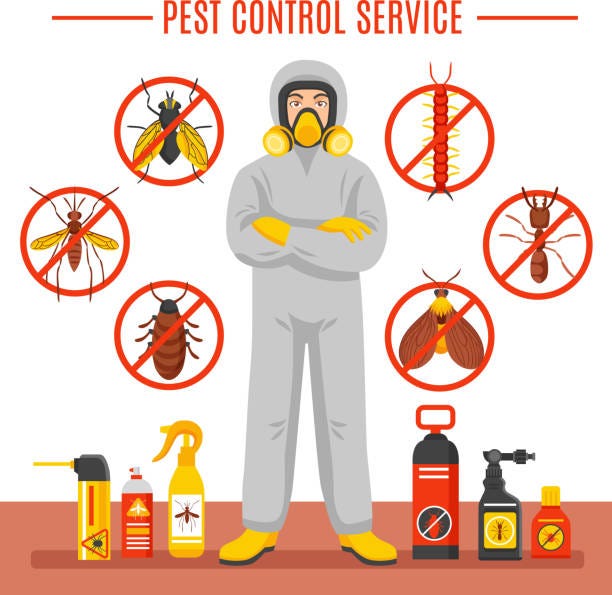Effective Bug Control Providers: A Thorough Check Out Elimination Techniques and Prevention Measures
In the realm of parasite control services, the successful administration of invasions calls for a thorough approach that incorporates numerous techniques and actions for both elimination and avoidance. From Integrated Bug Monitoring (IPM) approaches that focus on sustainable remedies to chemical elimination methods designed for targeted removal, the collection against bugs is vast and complex. Organic control approaches and physical avoidance steps supply alternate paths to successfully combating undesirable burglars. However, the trick to a comprehensive bug control plan lies not just in the methods themselves, but likewise in the careful expert examination treatments that come before and notify them. By comprehending the details of each strategy and exactly how they interaction, one can truly realize the intricacy and effectiveness of modern pest control services.

Integrated Bug Monitoring (IPM) Methods
Integrated Pest Management (IPM) Methods incorporate a comprehensive strategy to pest control that focuses on monitoring, control, and avoidance approaches to successfully manage insect populaces. By incorporating numerous techniques, IPM intends to decrease the influence of pests while likewise decreasing the dependence on chemical pesticides. Prevention exists at the core of IPM, highlighting practices like proper sanitation, upkeep of hygiene, and securing access factors to deter pests from infesting structures.
Chemical Elimination Methods
Chemical elimination strategies are frequently employed in parasite control services to effectively get rid of insect populations that present a danger to human health and wellness and residential property. These methods involve using different chemical compounds particularly developed to target and remove insects such as insects, rats, and various other unwanted animals. The application of chemicals, pesticides, rodenticides, and various other chemical representatives is meticulously regulated to guarantee maximum performance while reducing threats to people, animals, and the setting.
One of the key advantages of chemical extermination strategies is their capacity to offer quick and targeted results, making them particularly beneficial in instances of serious invasions or urgent parasite control needs - a1 pest control portland bed bugs. However, it is important to emphasize the value of proper handling, application, and disposal of these chemical products to stop unintended injury
In addition, integrated bug management (IPM) approaches often integrate chemical extermination techniques with other approaches such as cleanliness, environment modification, and organic controls to create a sustainable and detailed bug control technique. By integrating chemical elimination strategies carefully within an IPM structure, pest control solutions can effectively take care of parasite populaces while lessening potential threats to human health and the setting.
Biological Parasite Control Techniques
Utilizing all-natural killers and bloodsuckers to manage bug populaces is a sustainable method known as organic pest control. This approach uses the natural devices of the community to manage parasite populaces without counting on artificial chemicals. One common biological control approach includes presenting natural adversaries of the target bug species, such as ladybugs for aphid control or nematodes for termite problems. These natural predators feed upon the parasites, aiding to maintain their populations in check.
One more effective biological control strategy is making use of microbial pesticides. These are naturally taking place microbes, such as viruses, fungi, and germs, that particularly target and contaminate specific insect species. By utilizing these microbial agents, parasite populations can be effectively reduced without hurting helpful organisms or triggering injury to the setting.
Physical Pest Avoidance Actions
Carrying out physical pest avoidance site web steps entails using barriers and structural adjustments to deter pests from infesting a building or going into (a1 portland bed bug exterminator). One efficient method is securing all possible entrance factors such as spaces around doors, windows, and energy infiltrations. Installing door moves, displays on home windows, and sealing cracks in the structure can assist protect against parasites like pests and rodents from getting inside. In addition, keeping a clutter-free and clean setting is important as insects are drawn in to food resources and hiding areas. Consistently examining and fixing any broken displays, vents, or roof covering floor tiles can likewise help in keeping parasites out.
An additional physical avoidance procedure is using barriers like secure fencing to keep bigger insects such as deer or raccoons away from the residential or commercial property. Installing mesh or cable screens around gardens can safeguard plants from being damaged by insects. Proper waste management, consisting of protecting garbage canisters with tight-fitting covers, is vital in deterring pests like insects, rats, and raccoons. By implementing these physical parasite avoidance procedures, homeowner can significantly lower the risk of insect infestations and the damage they can create.
Specialist Insect Assessment Procedures
Carrying out organized and complete bug examinations is a fundamental element of professional parasite monitoring procedures. Specialist pest assessors are trained to thoroughly analyze residential properties for signs of invasions, recognizing pest types, entry factors, and conducive conditions.

Verdict
To conclude, efficient pest control services utilize a range of methods, including Integrated Insect Administration methods, chemical elimination approaches, biological controls, and physical prevention measures. Specialist bug assessment treatments play an important role in identifying and resolving pest from this source concerns in a timely manner. how to eliminate bed bugs By carrying out a combination of these approaches, residential or commercial property proprietors can successfully protect against and take care of pest problems.
From Integrated Bug Administration (IPM) strategies that prioritize lasting solutions to chemical elimination techniques created for targeted elimination, the collection against parasites is complex and large.Integrated Insect Management (IPM) Strategies incorporate a detailed strategy to pest control that concentrates on control, prevention, and surveillance approaches to successfully manage parasite populaces.Chemical elimination strategies are frequently used in pest control solutions to successfully remove insect populations that pose a risk to human health and wellness and building.Using natural predators and bloodsuckers to manage pest populations is a sustainable approach known as organic pest control.In final thought, reliable pest control solutions use a range of strategies, consisting of Integrated Insect Administration methods, chemical elimination approaches, biological controls, and physical avoidance steps.